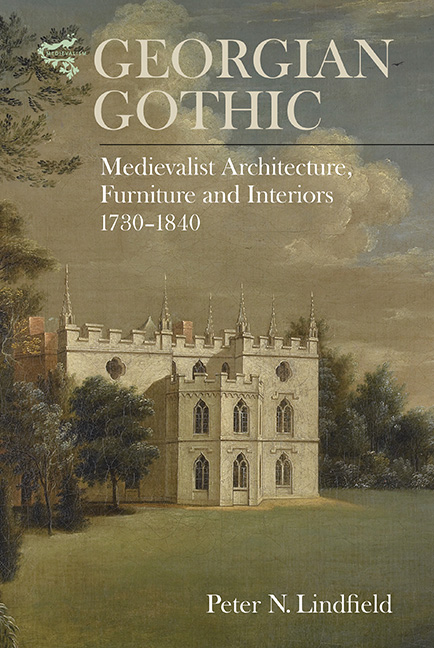Book contents
- Frontmatter
- Dedication
- Miscellaneous Frontmatter
- Contents
- List of Illustrations
- Acknowledgements
- Introduction: the Gothic Aesthetic in Britain and British Furniture, 1730–1840
- 1. Understanding Gothic Architecture in Georgian Britain
- 2. Creation of Classical Gothic Architecture, Furniture and Interiors
- 3. High Fashion and Fragments of the Past: the Omnipresence of Rococo Gothic
- 4. Fluctuating Tastes: Gothic in Later Eighteenth-century Britain
- 5. The ‘Chaos of Modern Gothic Excrescences’: Regency to Revolution
- Conclusion
- Appendix
- Bibliography
- Glossary
- Index
- Miscellaneous Endmatter
- Frontmatter
- Dedication
- Miscellaneous Frontmatter
- Contents
- List of Illustrations
- Acknowledgements
- Introduction: the Gothic Aesthetic in Britain and British Furniture, 1730–1840
- 1. Understanding Gothic Architecture in Georgian Britain
- 2. Creation of Classical Gothic Architecture, Furniture and Interiors
- 3. High Fashion and Fragments of the Past: the Omnipresence of Rococo Gothic
- 4. Fluctuating Tastes: Gothic in Later Eighteenth-century Britain
- 5. The ‘Chaos of Modern Gothic Excrescences’: Regency to Revolution
- Conclusion
- Appendix
- Bibliography
- Glossary
- Index
- Miscellaneous Endmatter
Summary
We all have some notion, most of us a very determined one, of the meaning of the term Gothic; but I know many persons have this idea in their minds without being able to define it: that is to say, understanding generally that Westminster Abbey is Gothic, and that St. Paul's is not, that Strasburg Cathedral is Gothic, and St. Peter's is not, they have, nevertheless, no clear notion of what it is that they recognize in the one or miss in the other, such as would enable them to say how far the work at Westminster or Strasburg is good and pure of its kind; still less to say of any nondescript building, like St. James's Palace or Windsor Castle, how much right Gothic element there is in it, and how much wanting.
(John Ruskin, 1853)TODAY, AS IN the eighteenth and nineteenth centuries, Gothic architecture and its motifs are etched firmly into Britain's landscape. These buildings are a legacy of British architectural and political history, venerable monuments to their patrons and architects, and fundamental landmarks of religious, educational and secular institutions. Some still dominate our village-, town- and cityscapes, including the cathedrals of Canterbury, Durham and Gloucester, the ruined cathedrals at Elgin and St Andrews, and the many colleges at Oxford and Cambridge. Others are ever-present, albeit hidden behind later developments, such as the cathedrals at Chester and Peterborough. Even when obscured, these structures feature consistently across Britain's landscape, and are a palpable reminder of the country's past.
Gothic architecture is a nationally important style in terms of geographic reach, occurrence and persistence, or ‘survival’, from the Middle Ages to the present. This is reflected in the number of volumes published in the eighteenth and nineteenth centuries that recorded Gothic buildings, fragments and even furniture. Notable examples are Paul Sandby's The Virtuosi's Museum; Containing Select Views, in England, Scotland, and Ireland (1778), the Society of Antiquaries of London's Vetusta Monumenta series (1747, 1789, 1796) and their journal Archaeologia (1770–), as well as John Britton's Architectural Antiquities of Great Britain (1807–26) and Cathedral Antiquities of England (1814–35).
- Type
- Chapter
- Information
- Georgian GothicMedievalist Architecture, Furniture and Interiors, 1730-1840, pp. 222 - 227Publisher: Boydell & BrewerPrint publication year: 2016

